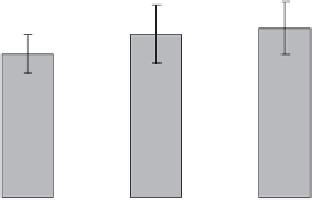Biomedical Engineering Reference
In-Depth Information
1.6
1.18
1.2
1.15
1.06
0.8
0.4
HVOF1
HVOF2
HVOF3
Specimen designation
FIGURE 4.26
Critical strain energy release rate (
G
ss
) of the HA coatings obtained from 4-point bend test. (HVOF1, HA coating
made from 50 ± 10 μm powder; HVOF2, HA coating made from 40 ± 10 μm powder; HVOF3, HA coating made
from 30 ± 10 μm powder.) (From Li et al.,
Eng. Fract. Mech.
, 74, 1894-1903, 2007a. With permission.)
coatings are in the range of ~20 to 110 nm (Li et al. 2007a). These should act as the crack
path and accelerate the crack propagation as well during the bending. Typical failure mor-
phology reveals that there is no evidence of cracking parallel to the surface of lamellae.
The trace of the brittle fracture suggests that the existed defects at the splats' interface
might have been connected together as the propagation path of the crack. Furthermore,
the size and distribution of pores also play an important role in influencing both the crack
initiation and propagation processes (Ishihara et al. 2000); thus failure would occur when
sufficient micropores have been connected by an unbonded area between splats and trans-
lamella microcracks to separate that region from the remainder of the coating. The effect
of micropores located along the crack propagation path on the fracture toughness has been
discussed by Leguillon (1997). It was believed that the crack growth was made of succes-
sive sudden jumps at each void along the crack path. Thus, the existence of micropores
at the crack propagation path (splats' interface in this case) is detrimental to the fracture
property. Furthermore, it has been found that the thickness of the retained coating is very
much consistent with that of one splat or two. Nevertheless, the cohesion inside individual
splats is much better than that between individual HA splats, which also accounts for the
bending crack propagation along the splats' interface. Since the fracture occurred within
the coating, the existence of the hexagonal nanosized grains did not show obvious influ-
ence on the crack growth.
NanostructuredHA-BasedCompositeCoatings
HA materials are poor in the property, which can lead to the instability of surface crys-
tals in the presence of body fluids and local loading. In addition, HA cannot withstand
applied loading force (de Putter et al. 1987). Especially in a body environment, the
mechanical strength of HA is further reduced considerably by fatigue (Heimke et al. 1987).
Therefore, HA needs to be strengthened. A bond-coat made from bioinert ceramic and the



Search WWH ::

Custom Search